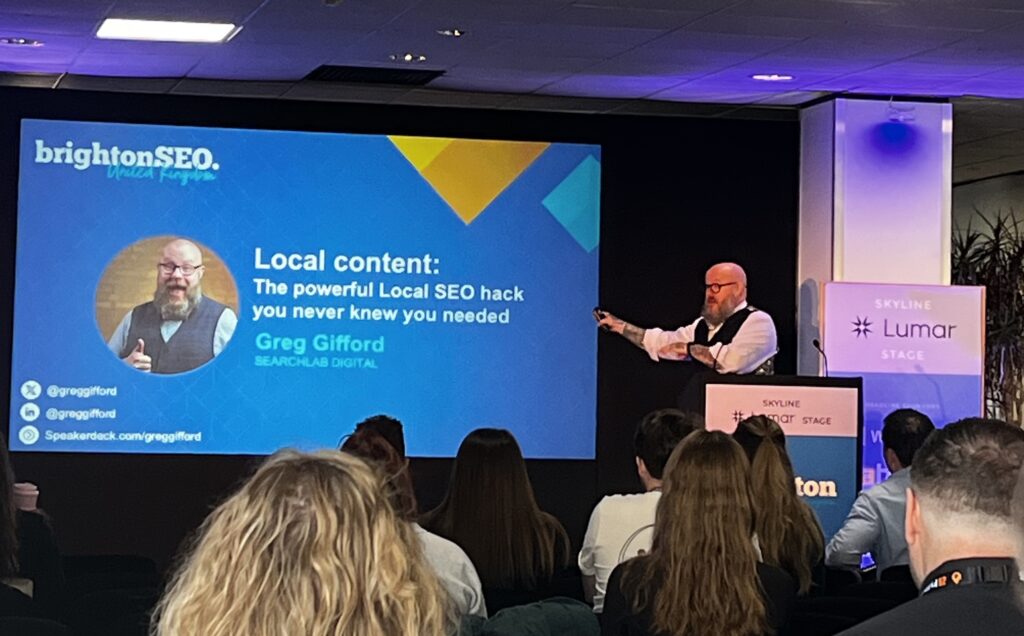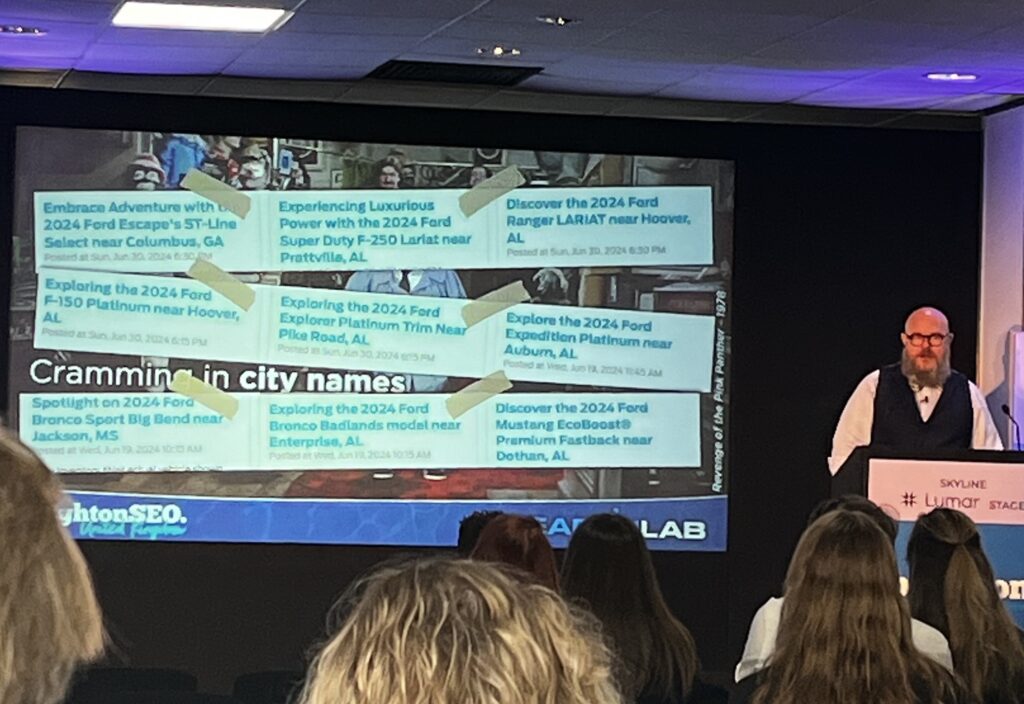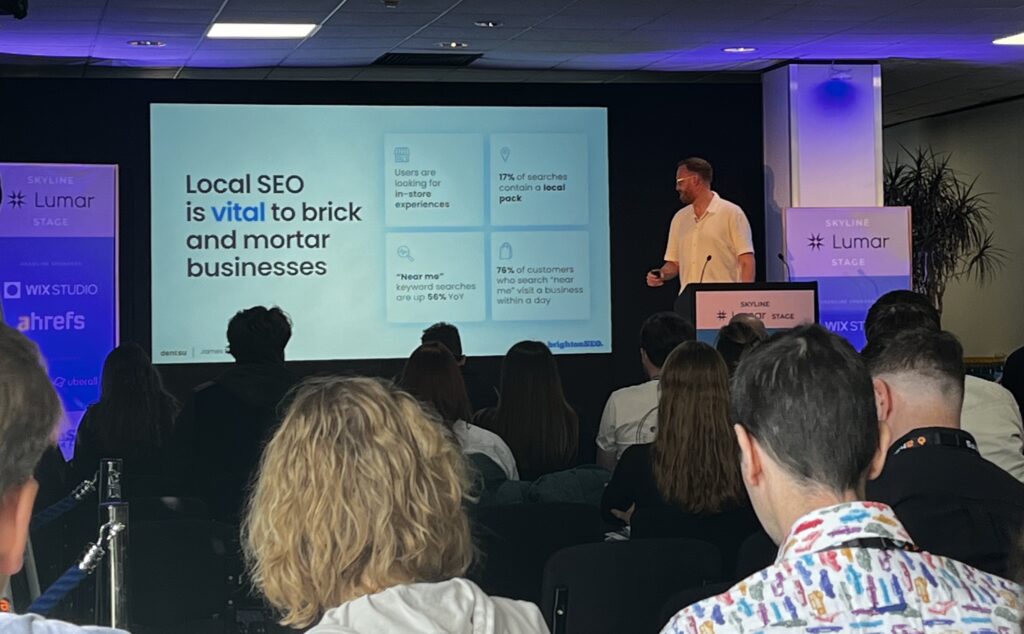Last week, thousands of SEO and digital marketing professionals gathered in Brighton for BrightonSEO, one of our industry’s biggest events of the year.
At the Lumar Stage, we hosted 20+ speakers over two days — covering everything from actionable technical SEO strategies to the impact of AI on organic search.
Here, we’re collecting some key takeaways on local SEO strategies shared by the SEO experts at Brighton.
Speakers include:
- Michel van Luijtelaar, Co-Founder, GMBapi.com
- Greg Gifford, Chief Operating Officer, SearchLab Digital
- James Foley, SEO Director, Dentsu
Top Takeaways: Local SEO Tips from BrightonSEO 2024
- Ensure you are actively managing your Google business profile.
- Reviews — both on Google properties and third-party review websites — are crucial for local SEO.
- Google’s AI Overviews also appear for local searches, and reviews for your business will also be important for generative search results.
- When creating content for local SEO, do not simply republish the same blog post with different locations named in the H1.
- When building the pages you want to rank for local searches, incorporate real user feedback and preferences as well as local SEO best practices.
Michel van Luijtelaar on Local SEO, Google Business Profiles, & the Importance of Reviews
Online reviews remain crucial for local SEO, said Michel van Luijtelaar, co-founder of GMBapi.com. Google aggregates your businesses’ reviews from across multiple third-party review websites, so savvy local search marketers will need to ensure they are paying attention to — and encouraging customers to post — reviews across multiple platforms, not just Google Maps. Using a Google review management tool can help streamline this process, ensuring you stay on top of reviews across all relevant platforms.
![Michel van Luijtelaar discussing Local SEO on the Lumar stage at BrightonSEO – Slide text reads: "Reviews are THE major ranking factor [for local SEO]"](https://www.lumar.io/wp-content/uploads/2024/10/crop-Michel-van-Luijtelaar-Local-SEO-Multi-Site-Biz-BrightonSEO-1024x605.jpg)
“Reviews are the backlinks of local SEO,” said van Luijtelaar. But asking your customers to review your business is just the first step — he suggests local SEO teams set internal targets for gathering reviews to ensure you have a steady stream of new reviews coming in. And be sure your team is also interacting with reviews as they come in to boost engagement, mitigate the risks of negative reviews, and encourage more customers to post positive feedback. If the occasional fake review gets posted by a competitor, van Luijtelaar shared, you can generally ask the review platform to take these down if you have enough evidence to prove these are not genuine customer reviews.
He also encourages local SEOs to ensure they are proactively managing their Google business profiles — if you don’t, he warns, someone else may manage it for you (he gave the example of high school students changing their schools’ name to ‘Hawk Tuah High School’ in light of the recent meme). Ignoring your Google business profile makes your company vulnerable. He notes that you can now also add your social media links to your business profile to encourage additional engagement from prospects and customers.
Greg Gifford on How to Create Better Content for Local SEO
We’ve discussed the importance of reviews for local SEO, but what about your own website’s content?
Greg Gifford, Chief Operating Officer at SearchLab Digital, took to the Lumar stage to dive deep into all things content for local SEO.

Gifford encourages local SEO professionals to remember that the ‘local’ algorithm for Google Search differs from the traditional search algorithm. You have to link-build differently, optimize differently — and create content differently.
Don’t make content solely to rank in local searches, he suggests, citing the example of one blog post recycled over and over with just different city names substituted in the H1 tags. Taking this lazy approach is not “doing local SEO.” Instead, focus on creating content that actually makes your site better for your customers and prospects who are looking for what you offer in their local area.

Most people aren’t thinking enough about the conversion aspect of their website content, says Gifford. But if you don’t have genuinely good content on your website, not only won’t you show up at the top of the SERPs, but you also won’t answer peoples’ questions — so you won’t convert.
Furthermore, Gifford recommends adding content for all stages of the funnel — not just extreme bottom-of-the-funnel content. Yes, you want to get leads and sales, but good content gets you “eyeballs” — which can turn into leads in later sessions. Not everything you do as a digital marketer is going to provide immediate leads — but you want to make sure you are top-of-mind when a customer is ready to buy. Which means serving them well across the entire customer journey. Gifford makes the point that, as a business, you want prospective customers’ eyes on your website as early as possible — even before they are looking to buy what you’re selling.
It’s also worth noting that you won’t get a “map pack” in the SERPs for a city your business is not physically located in. So, for neighboring cities you serve, you’ll need to rely on organic search rather than enhanced SERP features like map packs.
However, the way to get organic search results for these neighboring cities isn’t by recycling blog posts with different city names, as in Gifford’s previous example.
Instead, he recommends several different content approaches that can help you climb in local search ranks. Blog post ideas that might work well for your business in local search include:
- Covering local news that is relevant to your product or service offering
- Local events coverage — especially if your business participates in that event
- Local interviews with relevant people in your community
- Creating local event guides — for example: where to stay, what to eat, what to see and do.
- Creating local resource guides — or reviewing other businesses you enjoy. (“People want to ‘shop local,’” says Gifford.)
- “Top 5 X in X City” — Posts that cover the top 5 options for various activities, businesses, or events in your city.
- Aggregating other content about your local area into an ‘ultimate guide’ style blog post.
James Foley on How to Create the Perfect Page for Local SEO
James Foley, SEO Director at iProspect (a Dentsu company), simplified the process for creating the perfect local SEO page.
Local SEOs need to focus on two key elements when optimizing their websites, says Foley:
- User Feedback
- Local SEO Ranking Factors
The elements on your page should be based primarily on these two factors. Speak to your users to find out more about what they want — then create that content and ensure you’re touching on local SEO best practices as you build your pages.

He outlines his general process for building high-ranking, user-friendly local SEO pages across 3 stages:
- Analysis:
- Conduct keyword research
- Do a competitor review to identify immediate opportunities for content creation
- Conduct heat mapping, live user feedback sessions, and journey mapping
- Analyze findings — how do you fix any problems you’ve uncovered in this analysis phase?
- Page Creation:
- Create page wireframe
- Optimize content
- Ideation session
- Page design
- Page Testing:
- Begin rapid prototyping
- Publish your content
- Monitor SEO performance
- Deep dive into the results
Foley also shared some general tips for improving local SEO:
- Build separate location pages if you have multiple brick-and-mortar store locations
- Ensure “NAP” (name/address /phone number) are all visible ‘above the fold’ on your page — this is often the first thing local web visitors want to find on your page.
- Ensure there is a functional map on your site (this is both a local SEO ranking factor and something often cited positively in user feedback)
- Include target keywords in your title tag
- Full opening hours should be displayed on the page (including hours for bank holidays, etc.) — users often complain when this data is not updated.
- Include FAQs for both your customers — and to rank for more SERP features.
- Include pages for your in-store events on your website — not just on social media.
- Add videos that help users learn more about your brand.
- Add user reviews and testimonials — potential customers want to know they can trust you before they purchase.






